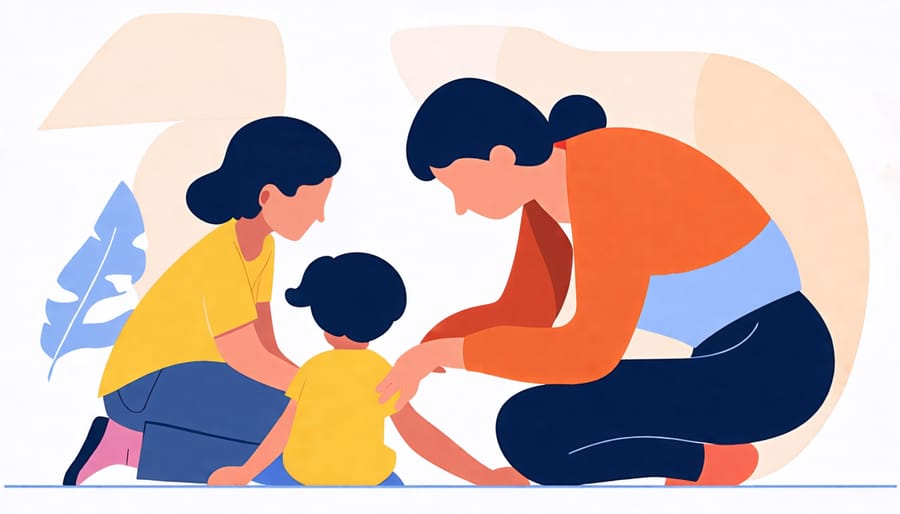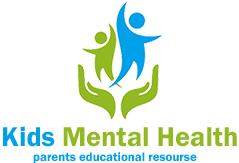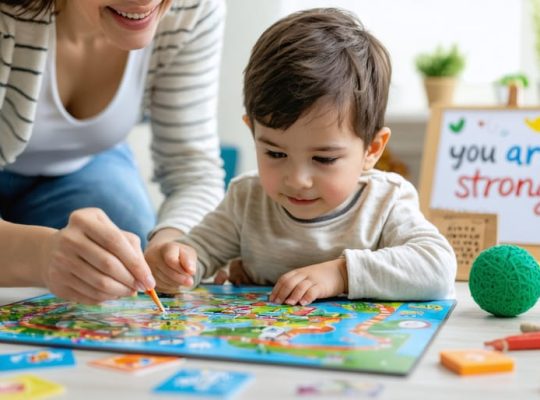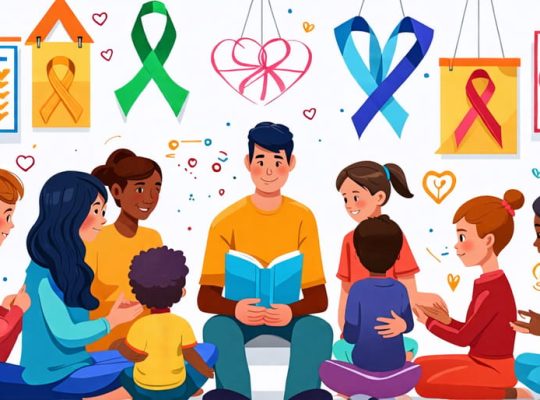1. Recognize the signs of PTSD in your child, which may include intrusive memories, avoiding triggers, negative changes in thinking and mood, and changes in physical and emotional reactions. If your child has experienced or witnessed a traumatic event and is exhibiting concerning behavioral changes for more than a month, seek professional help.
2. Consult with your child’s pediatrician or a mental health professional specializing in child trauma. They can conduct a comprehensive evaluation, identify co-occurring conditions, and recommend appropriate treatment options. Early intervention is crucial for managing symptoms and promoting healthy coping strategies.
3. Support your child’s recovery by creating a safe, stable environment at home. Encourage open communication, validate their feelings, and reassure them that the traumatic event was not their fault. Help them distinguish between stress and trauma reactions. Maintain routines and engage in calming activities together.
4. Collaborate closely with your child’s treatment team to implement therapeutic interventions, which may include trauma-focused cognitive behavioral therapy, play therapy, or family therapy. Prioritize self-care for yourself and seek support from trusted friends, family members, or support groups for parents of children with PTSD.
Recognizing the Symptoms of PTSD in Children

Emotional and Behavioral Changes
Children with PTSD may experience a range of emotional and behavioral changes that concern parents and caregivers. Heightened anxiety is common, with fears and worries that seem out of proportion to the situation. Some children become more withdrawn, avoiding social interactions and losing interest in activities they once enjoyed. Others may act out aggressively, lashing out at family members or peers.
Regressive behaviors, such as bedwetting or thumb-sucking, can emerge in children who have previously outgrown these habits. Sleep disturbances, including nightmares and difficulty falling or staying asleep, are also frequent. Parents might notice their child is easily startled, jumpy, or overly vigilant about potential threats.
Mood swings and irritability are other red flags, as children struggle to regulate their emotions. Some may have trouble concentrating or appear “spaced out” as they relive traumatic memories. Older children and teens might engage in risky behaviors, self-harm, or substance abuse as a way to cope with overwhelming feelings.
If you notice a significant change in your child’s emotions or behaviors that persists for several weeks or interferes with daily life, it’s important to seek help from a mental health professional experienced in treating childhood trauma. With support and treatment, children can learn healthy coping skills and begin to heal.
Physical Symptoms
Physical symptoms of PTSD in children can manifest in various ways. Sleep disturbances, such as nightmares, insomnia, or difficulty falling asleep, are common. Children may also experience frequent headaches or stomachaches without an apparent medical cause. Changes in eating habits, such as loss of appetite or overeating, can occur as a response to stress and anxiety. Some children may report feeling physically ill or develop unexplained aches and pains. Bedwetting, even if the child had previously outgrown this behavior, can resurface. In some cases, children may exhibit an exaggerated startle response to sudden noises or movements. Pay attention to any physical complaints your child expresses and consider them in the context of their overall behavior and recent experiences. While these symptoms alone do not necessarily indicate PTSD, they warrant further observation and discussion with a healthcare professional if they persist or interfere with daily functioning.
Re-experiencing the Trauma
Children with PTSD may re-experience the traumatic event in various ways. Nightmares are common, causing the child to wake up frightened, disoriented, or crying. During the day, they might have flashbacks – vivid, intrusive memories that make them feel as if the trauma is happening again. These can be triggered by sights, sounds, or smells that remind them of the event. Children may also engage in repetitive play, acting out aspects of the trauma. For example, a child who witnessed a car accident might repeatedly crash toy cars together. These re-experiences can be distressing and confusing for the child, making them feel unsafe and anxious. If your child is exhibiting these symptoms, it’s essential to provide a safe, supportive environment and seek guidance from a mental health professional experienced in working with children who have experienced trauma. Remember, with the right support, children can learn to cope with their experiences and heal from PTSD.
When to Seek Professional Help
If your child’s PTSD symptoms persist for more than a month and interfere with their daily life, it’s crucial to seek professional help. Untreated PTSD can lead to long-term mental health issues, affecting a child’s social, emotional, and academic development. Children may struggle to form healthy relationships, perform well in school, or manage their emotions effectively. By acting quickly and seeking support from a mental health professional experienced in treating childhood trauma, you can help your child begin the healing process and develop coping strategies to manage their symptoms. Remember, early intervention is key to preventing the long-term effects of PTSD and promoting your child’s overall well-being. Don’t hesitate to reach out for help if you suspect your child is struggling with PTSD – with the right support and treatment, they can learn to navigate their trauma and build resilience for a brighter future.
Finding the Right Mental Health Professional
Finding the right mental health professional for your child is crucial in diagnosing and treating PTSD. Start by asking for referrals from your child’s pediatrician, school counselor, or trusted friends and family members. Look for a licensed child psychologist or therapist who specializes in trauma-informed care and has experience working with children who have experienced traumatic events.
When researching potential providers, check their credentials, read reviews, and ask about their treatment approach. It’s important to find a professional who creates a safe, supportive environment and uses evidence-based techniques such as cognitive-behavioral therapy (CBT) or eye movement desensitization and reprocessing (EMDR).
Consider your child’s unique needs and preferences when selecting a therapist. Some children may feel more comfortable with a male or female provider, while others may respond better to a particular therapeutic style. Don’t hesitate to ask questions and trust your instincts when making this important decision. With the right support, your child can begin the path to healing and recovery.
Supporting Your Child’s Healing Journey
Encouraging Open Communication
When your child is struggling with the aftermath of a traumatic event, one of the most important things you can do is create a safe, non-judgmental space for them to open up. Encourage your child to share their thoughts and feelings at their own pace, without pressure. Listen actively and avoid interrupting or rushing to offer advice. Validate their emotions by acknowledging their pain and letting them know it’s okay to feel whatever they’re feeling. Resist the urge to minimize their experience or compare it to others. Instead, focus on showing empathy and understanding. Reassure your child that you’re there to support them unconditionally and that seeking help is a sign of strength, not weakness. Remember, even if you can’t fully understand what they’re going through, simply being present and offering a listening ear can make a world of difference in your child’s healing journey.
Collaborating with Treatment Providers
Collaborating with your child’s mental health provider is key to supporting their recovery from PTSD. Attend appointments together to learn about the diagnosis, treatment plan, and coping strategies you can practice at home. Share insights about your child’s symptoms, triggers, and progress. Reinforce the skills they’re learning in therapy, like relaxation techniques or journaling, by making them part of your family’s routine. Maintain open communication with the therapist about any concerns or breakthroughs. Remember, you’re an integral part of your child’s support system. Consistency and patience are essential as your child works through trauma. Celebrate their resilience and progress along the way. With love, professional guidance, and coping tools, your child can heal and thrive.

Self-Care for Parents and Caregivers
As a parent or caregiver, supporting a child with PTSD can be emotionally taxing. It’s essential to prioritize your own mental health and well-being to avoid burnout. Engage in self-care activities like exercise, meditation, or hobbies that bring you joy. Seek support from friends, family, or a therapist when needed. Remember, taking care of yourself enables you to be a better caregiver for your child. Joining a support group for parents of children with PTSD can provide validation, resources, and a sense of community. Don’t hesitate to reach out for help—your well-being matters too.







